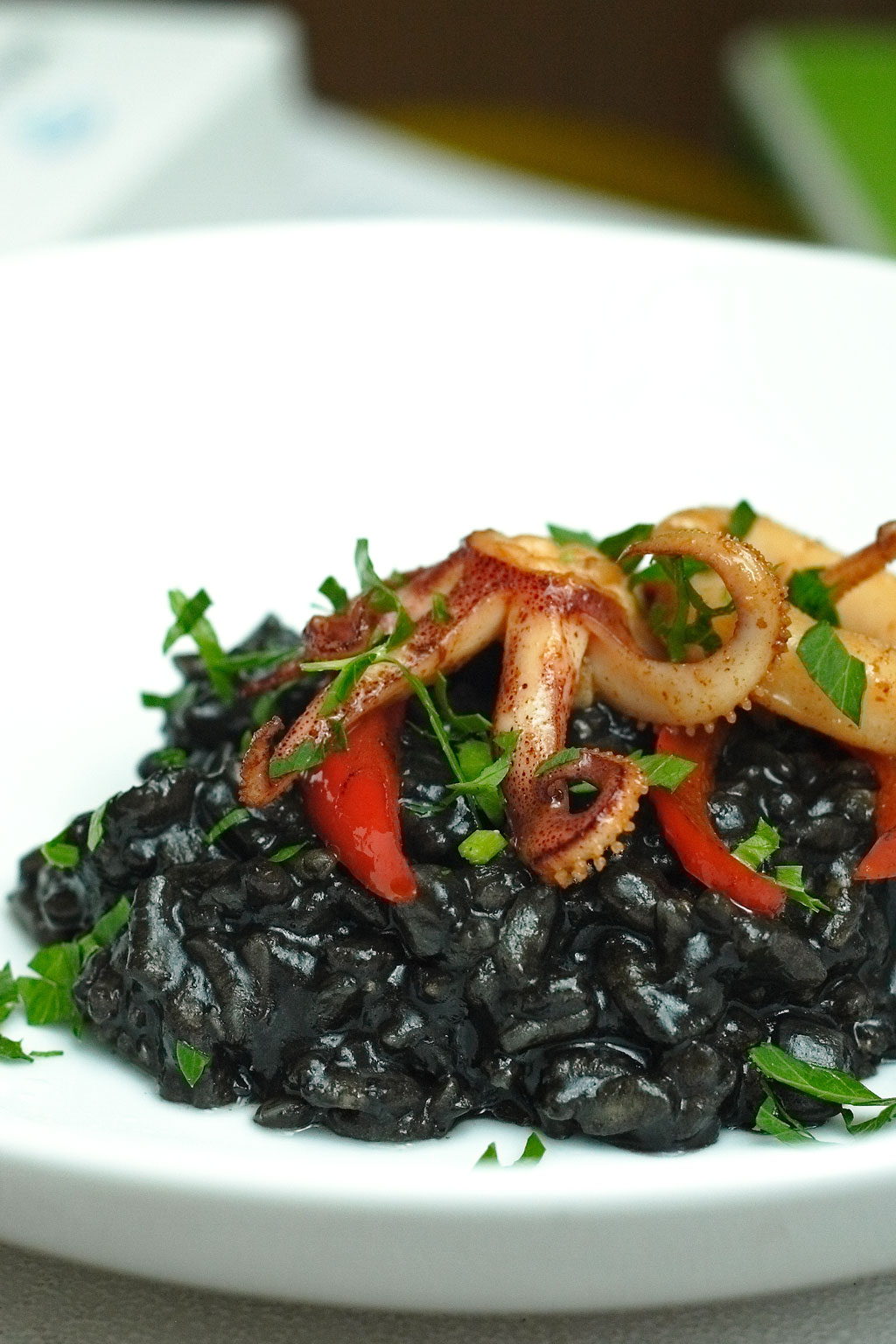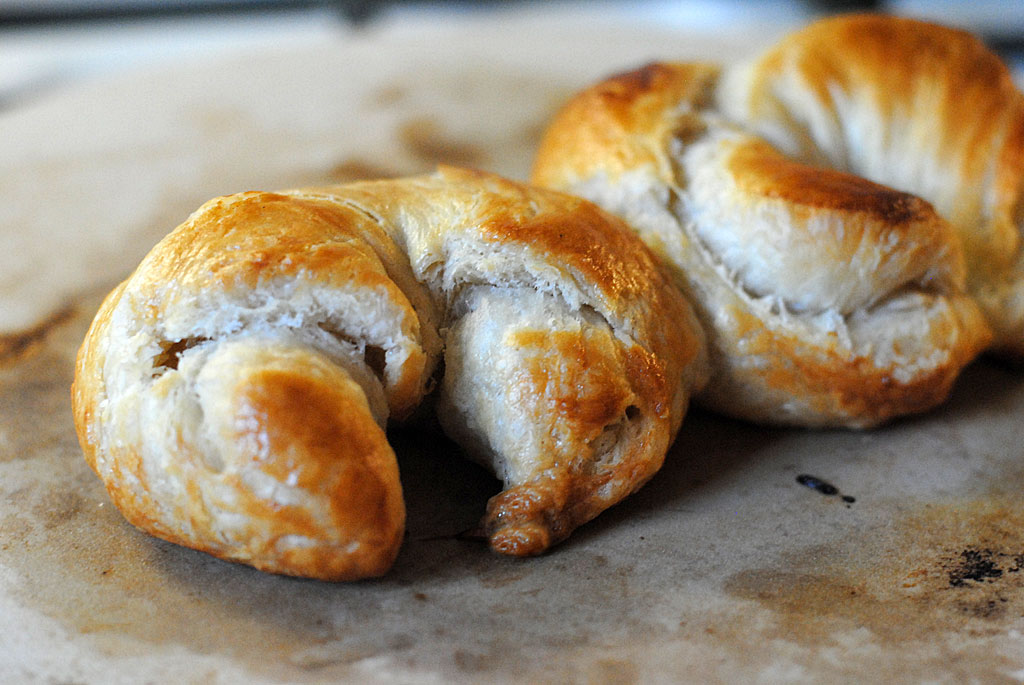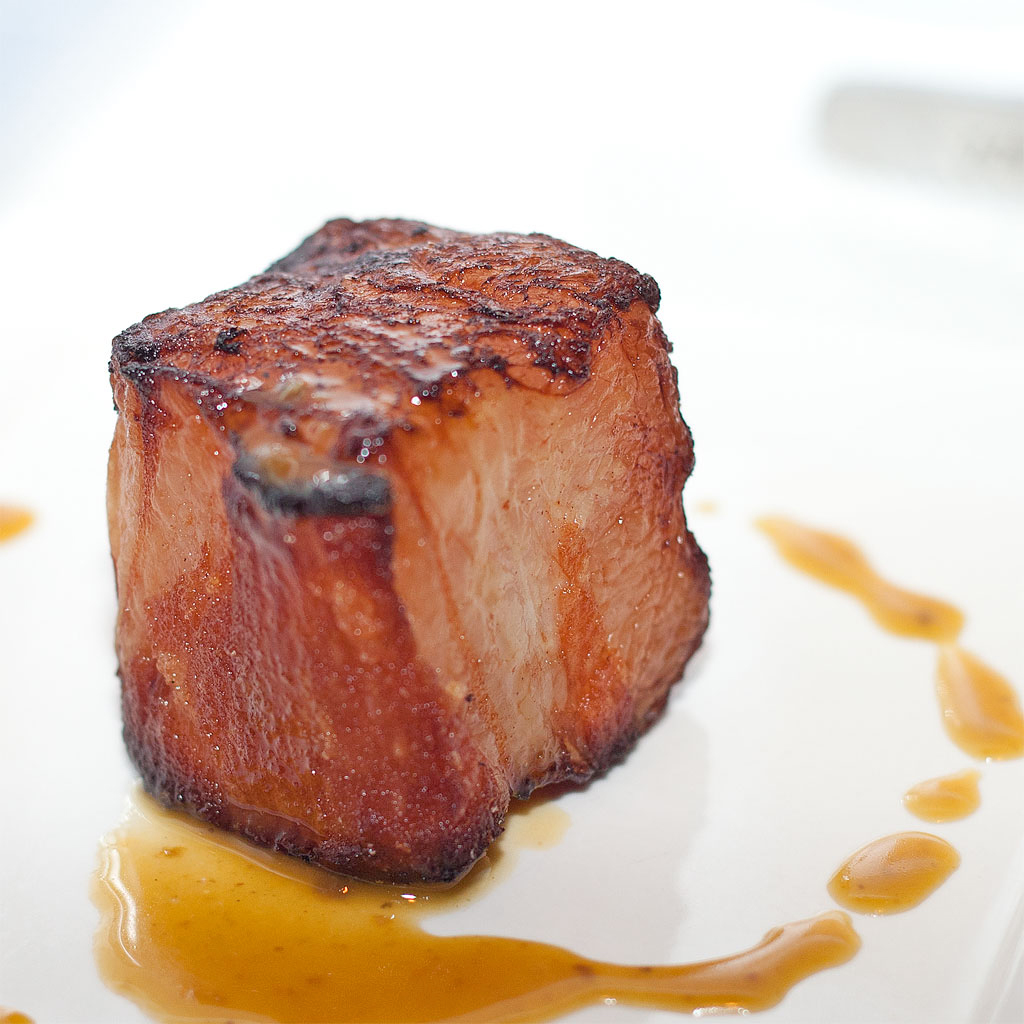Here’s my take on a very delicious and strikingly looking Italian dish, risotto Nero, a beautiful and simple risotto cooked in sumptuous squid ink and fish stock. I have topped this dish with sautéed calamari, with a touch of sweet paprika and deglazed this with a splash of dry Noilly Prat, garnished with some red bell peppers for texture and color. The total cooking time is about 40 minutes, risotto is only ready when is ready, so pay attention to the pan, stir regularly, hydrate the rice little by little, adjust seasoning, taste taste taste along the way. And do not overcook the rice, the grains should still have a little bit of a bite to them, and the overall texture should be creamy. This dish is simply delicious, and if you are one of those out there freaked out by the concept of eating squid ink or by its looks, give it a try, it will blow your mind!
Gear:
2 cutting boards + knife ( I cut the squid in a separate board)
deep skillet, I use my cast iron deep pan
medium saute pan
spatula
bowls and containers for prepping
strainer

Ingredients:
Risotto:
3 packets of squid ink (about 2-3 tsp)
1 squid ink sack
1 large squid about 250g
1 cup of arborio rice
2 cups fish stock (low sodium, store bought)
2 cups of water
2 garlic cloves
1 tbs tomato paste
1/4 diced large onion
1/2 cup dry vermouth
1 tbsp butter
salt and white pepper to taste
olive oil to saute
parsley and lemon juice

Squid :
1 tsp paprika
1 tsp sea salt
1 black pepper
2 tbsp dry vermouth
olive oil
julienned red bell peppers
lemon juice

Method:
Squid:
01: clean squid under cold water
02: pull legs/head away from the main tubular body
03: if ink in the sack, collect (add it to risotto when adding ink packets)
04: cut the head right under the eyes, discard the top, keep the legs
05: peel skin off the body using your fingers
06: rip the fins off using your fingers
07: cut the tube into rings about 2/3 cm width
08: rinse everything in a strainer and sit aside in the sink
09: you can pat the squid with paper towel to dry
10: julienne some red bell pepper
11: heat up medium skillet over high heat
12: add some olive oil, let get hot but not smoking
13: add squid and bell pepper, you should hear sizzling
14: sautee for about 3 minutes, tossing once or twice
14: while adding salt, pepper, paprika
15: add vermouth and flambé off the alcohol
16: reduce for a minute or 2 until bubbly
17: remove from heat, let rest.


Risotto:
01: dice all the veggies small
02: heat your risotto vessel to medium add olive oil
03: add onions and stir, sweat until translucent
04: add tomato paste, and a splash of water, reduce, cook
05: add garlic, don’t let brown
06: add squid ink and some fish stock, cook for 5 minutes
07: add rice and mix with everything until coated evenly
08: add vermouth
09: add more stock as needed, keep stirring
10: add some salt, pepper, more stock, taste, keep stirring
11: this process goes on for about 30 minutes
12: I usually add water after running out of fish stock
13: rice will probably need more liquid, up to 1 or 2 more cups
14: once rice is al dente and creamy, add butter, melt and stir in
15: remove from heat
16: check seasoning one last time, adjust if needed,
17: plate risotto, top with pepper/squid + pan drippings
18: sprinkle some chopped parsley
19: splash of lemon juice, drizzle of olive oil
20: done.


Notes:
vermouth vs white wine:
I really love using vermouth when cooking seafood or fish, actually, pork and chicken also welcome this fortified wine which contains a great combination of flavors like for example, cloves, cinnamon, quinine, citrus peel, cardamom, marjoram, chamomile, coriander, juniper, hyssop, and ginger. Italian of origin, I like to use it’s french readily available Noilly Prat dry vermouth. One advantage of using this wine is flavor consistency. Bottle after bottle, the differences in flavor aren’t obvious and its citrusy goes perfect with this dish.
on cooking squid:
Squid, buy only fresh, I’m lucky to live a few blocks away from a great japanese market that carries sashimi grade fish and seafood. One important thing to know about squid is its cooking time. Squid cooks within a few minutes, extended cooking will make the flesh extremely rubbery and unpleasant. Toss it in a super hot pan with some oil, 2-3 minutes if until opaque throughout.
on cleaning squid:
Ask your fishmonger to do this if you don’t want to deal with it, but I personally enjoy the preparation of it and it is quite simple. There are tons of youtube videos that show you exactly how to do this, so I won’t write a long paragraph about it. There are so many different species of squid is hard to keep up, but they all are cleaned the same way.
on cross contamination:
Whenever your cutting gear, boards and knife (your hands), are in contact with raw protein extra care must be taken. Specially if you are using this equipment to chop some ingredients that will go on the dish without cooking, like for example parsley being chopped on a board that was used to portion a raw chicken. Be really careful please. Use different cutting boards or wash throughly after cutting any raw protein on it before chopping something else. I like using different boards and keeping my knife clean at all times.
on cooking by approximation:
Most recipes might seem so precise and rigid, including ones on this blog, that a positive outcome seems almost guaranteed if we follow them. The cooking that led to them wasn’t necessarily that precise (baking is a different story), it was an exercise on approximation, more heat, less heat, more water, less salt, more time, taste this, taste that, so many tiny little adjustments to get to what a cook finally wants that it would be impossible to write down all that on a recipe. Use the recipes as guidelines. Over time, and by learning about cooking fundamentals and techniques, it will be easier to follow a recipe and forget about blindingly repeating each step. There will be posts in which we’ll get into more modernist approaches to cooking, but most dishes can be made with traditional techniques and equipment. Try to have fun in the kitchen no matter what, and if you enjoy washing dishes more power to you… I hate it.
Wanna get more sous-vide cooking guides and cool cooking how-to’s in your mailbox? You know what needs to be done!
We never spam. You should only be getting updates when new content is posted on the site. We also respect your privacy. We don’t share your email address with anyone and you can unsubscribe anytime!





19 comments
Love the presentation! Gorgeous. Does the ink stain your teeth when eating?
Hi Virginia, and thank you! I’m so glad you liked it. To answer your question quickly, I don’t remember squid ink staining my teeth even while eating it, I don’t eat squid ink frequently enough so maybe? 🙂 that being said, squid ink is water soluble and the concentration in the risotto is not enough to really have a staining effect. It’s messier to handle before you cook it, like your hands and cutting tables, but water and a little soap and it’s gone.
That’s good to know. I ask because a lot of red wine stains my teeth so I have a purple smile so was wondering about the black ink!
Wow!! I ate squid ink once before in San Francisco. Where did you get it?? -Jamie
Jamie, I live in Los Angeles, and I’ve found http://www.culinarydistrict.com (Surfas) to carry it but not online. It is safe to order online on say… amazon, the shelf life of squid ink is very long. 4 years at room temperature unopened, though I keep it in my fridge:
http://www.amazon.com/Squid-Ink-0-14-oz-pcs/dp/B003WQIOB6/ref=sr_1_2?ie=UTF8&qid=1370884693&sr=8-2&keywords=squid+ink
hope this helps!
A great recipe, Paul. Sepia ink makes for such a great presentation. Using the tentacles for garnish is such a great idea. I’ve searched for sepia ink for some time. Just today, the owner of a neighborhood pet shop, of all places, told me where I could find some. How’s that for a coincidence! I hope to get some and make pasta with it. I hadn’t thought to use it to make risotto — until now. 🙂
That is no coincidence, that was meant to be! 😉 hahah, so glad you enjoyed my post, I love cooking with squid ink and I’m glad I have access to it from a store. I have gone through the pain of collecting the ink sacks by hand, that is time consuming and messy but kinda fun. Here is a link to my squid ink pasta, I’d love your feedback:
http://thatothercookingblog.com/2012/12/25/the-misunderstood-squid-ink-pasta/
thanks John!
My gosh. I found your blog courtesy of John from the Bartolino Kitchens. I was going to soon post a recipe for risotto with squid ink … maybe it’s due for a tweak and I’ll do a black paella instead. But what a gorgeous blog: beautiful photos and writing. I’ve cooked seafood and vermouth (noilly prat) many times before, but have not added to risotto.I will have to try that next time I make a seafood risotto. Delighted for the introduction.
Susan! thank you so much for visiting my blog, and thank you for your great compliments! Specially after looking at yours, I’m humbled, what a beautiful site you have, your photography and your beautiful and creative work all together, is amazing. Glad we have John as a common link, I hold him as one of my main sources of inspiration when blogging about food, and now I have you too! 🙂
I’ve had this in Italy made with fresh ink and really liked it. This is one of the few things that Kees doesn’t eat, so I’m not very likely to prepare it. Great post with great photos and instructions, Paul!
Thanks John! has Kees tried it before? I can understand why people that never had it would be hesitant.. My family being half basque and my grandma being an excellent cook made sure we all would enjoy squid ink heheh
He has tried it several times in restaurants because we usually have the degustation and eat whatever they serve us. I thought the fresh was much nicer than dried ink spaghetti for instance (fresher cleaner flavor), but for him it stayed just ink.
that’s unfortunate, but it’s like me and eggplant, there’s no way!… until I try your recipe of course 😉
Eggplant has a more neutral flavor than squid ink, so it blends in more easily.
Awesome blog! Is your theme custom made or did you download it from somewhere?
A theme like yours with a few simple tweeks would really make my blog stand
out. Please let me know where you got your theme.
Cheers
thanks! I’m using the bueno theme, I can’t remember, but I think it’s free, and you can pay a little extra to have access to the css and edit it which I did, but minimally. Anyways, check it out. hope this helps!
i thought I had reply to you, but I’m not sure. I use the bueno theme which I think its free and I bought some upgrade on wrodpress that allows a bit more control, the customization was minor though. thanks for your nice comments!!!!
Haha! John! please, do not postpone your recipe on risotto nero, when it comes to italian cooking I go to you or stefan from http://stefangourmet.com. Looking forward to your posts and your version of this squid ink rice recipe! seriously.